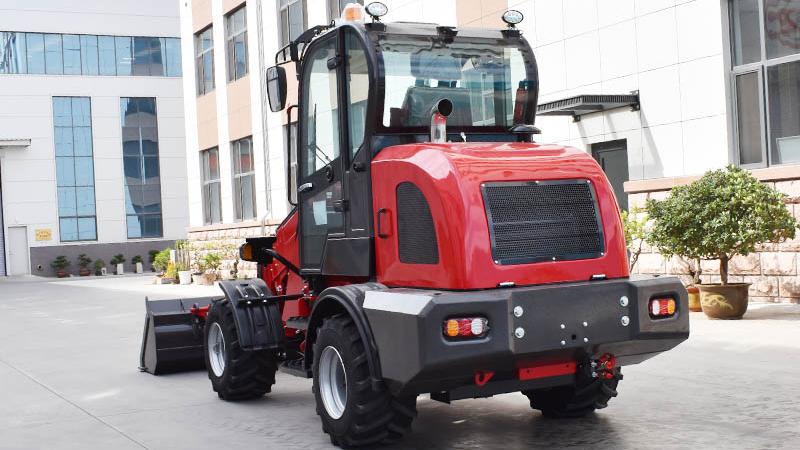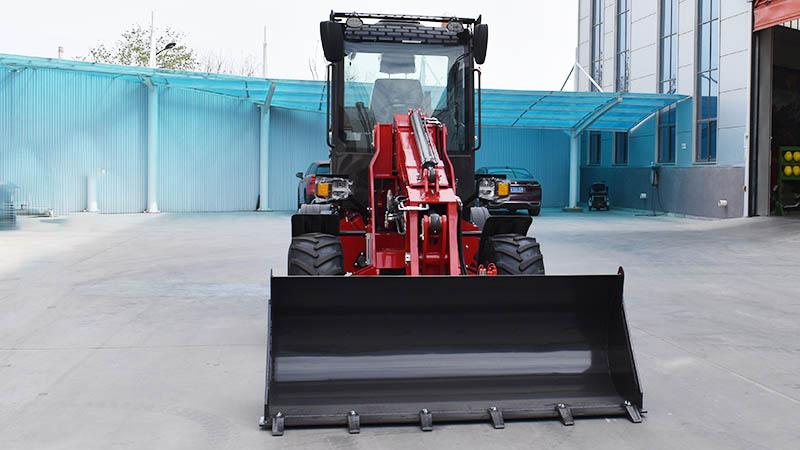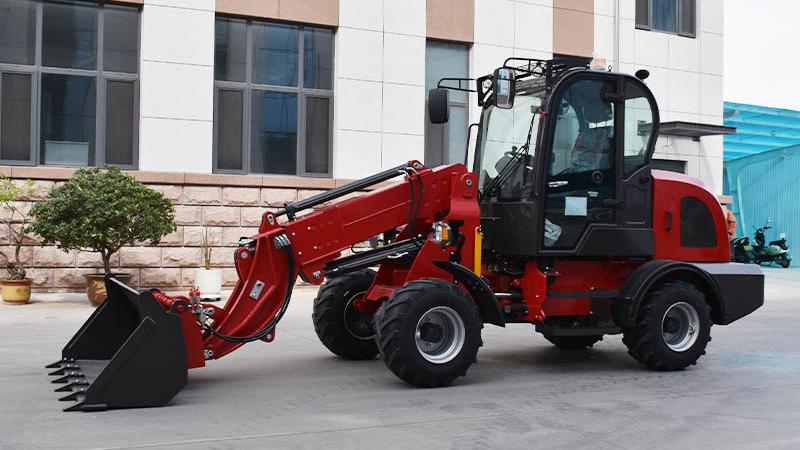Compact loaders are indispensable in construction and warehousing for handling heavy materials like palletized goods and cement bags. However, improper load calculations can lead to equipment failure or accidents. This comprehensive guide by MYZG explains how to determine your loader's safe lifting capacity while maintaining OSHA and manufacturer standards.
1. Understanding Key Lifting Capacity Concepts
1.1 Rated Operating Capacity vs. Actual Capacity
Rated Operating Capacity (ROC): The manufacturer's specified maximum safe load (e.g., MYZG CL-500 has a ROC of 5,000 lbs at a 24" load center).
Actual Capacity: Varies based on attachment type, load distribution, and terrain.
1.2 Load Center & Stability Triangle
The load center is the distance from the fork's heel to the load's center of gravity (CG).
Loaders become unstable if the CG moves outside the stability triangle (formed by the front wheels and pivot point).
1.3 Hydraulic System Limitations
MYZG loaders use high-pressure hydraulics (e.g., 3,000 PSI), but capacity drops if pumps or cylinders are worn.

2. Step-by-Step Calculation Method
2.1 For Pallets (Uniform Loads)
Formula: Safe Capacity = ROC × (Standard Load Center / Actual Load Center)
Example:
MYZG CL-500 ROC: 5,000 lbs at 24"
Pallet CG: 30" from fork heel
Calculation: 5,000 × (24 / 30) = 4,000 lbs
Considerations:
Add a 20% safety margin (4,000 × 0.8 = 3,200 lbs max).
Account for pallet weight (e.g., 50 lbs for wood).
2.2 For Cement Bags (Concentrated Loads)
Formula: Capacity = (Hydraulic Lift Force × Lift Arm Length) / (CG Distance × Safety Factor)
Example: MYZG CL-500 lift force: 6,000 lbs
Lift arm: 60"
Cement CG: 18"
Safety factor: 1.25 (OSHA)
Calculation: (6,000 × 60) / (18 × 1.25) = **16,000 lbs** (Theoretical) → Limited by ROC of 5,000 lbs.
Note: Always use the lower value between hydraulic capacity and ROC.

3. Critical Factors Affecting Capacity
Factor Impact MYZG Solution
Load Shape Uneven loads (e.g., bulging cement bags) shift CG. Use load stabilizers.
Attachment Weight Forks/grapples reduce available capacity. MYZG’s lightweight titanium forks save 15% vs. steel.
Terrain Slope >5° slopes decrease stability by ~30%. Tilt sensors warn operators.
Altitude Hydraulic efficiency drops ~3% per 1,000 ft. MYZG loaders feature high-altitude kits.
4. MYZG’s Loader Innovations for Safe Handling
Smart Load Monitoring: Real-time CG tracking via IoT sensors.
Auto-Decreasing ROC: Reduces capacity if instability is detected.
Dual-Fuel Options: LPG/gasoline models maintain power in cold cement plants.
5. OSHA & ANSI Compliance Checklist
✓ Never exceed ROC.
✓ Use load charts (find MYZG’s in the operator manual).
✓ Inspect hydraulics daily.
✓ Train workers on load moment principles.3. Critical Factors Affecting Capacity
Factor Impact MYZG Solution
Load Shape Uneven loads (e.g., bulging cement bags) shift CG. Use load stabilizers.
Attachment Weight Forks/grapples reduce available capacity. MYZG’s lightweight titanium forks save 15% vs. steel.
Terrain Slope >5° slopes decrease stability by ~30%. Tilt sensors warn operators.
Altitude Hydraulic efficiency drops ~3% per 1,000 ft. MYZG loaders feature high-altitude kits.
4. MYZG’s Loader Innovations for Safe Handling
Smart Load Monitoring: Real-time CG tracking via IoT sensors.
Auto-Decreasing ROC: Reduces capacity if instability is detected.
Dual-Fuel Options: LPG/gasoline models maintain power in cold cement plants.
5. OSHA & ANSI Compliance Checklist
✓ Never exceed ROC.
✓ Use load charts (find MYZG’s in the operator manual).
✓ Inspect hydraulics daily.
✓ Train workers on load moment principles.3. Critical Factors Affecting Capacity
Factor Impact MYZG Solution
Load Shape Uneven loads (e.g., bulging cement bags) shift CG. Use load stabilizers.
Attachment Weight Forks/grapples reduce available capacity. MYZG’s lightweight titanium forks save 15% vs. steel.
Terrain Slope >5° slopes decrease stability by ~30%. Tilt sensors warn operators.
Altitude Hydraulic efficiency drops ~3% per 1,000 ft. MYZG loaders feature high-altitude kits.
4. MYZG’s Loader Innovations for Safe Handling
Smart Load Monitoring: Real-time CG tracking via IoT sensors.
Auto-Decreasing ROC: Reduces capacity if instability is detected.
Dual-Fuel Options: LPG/gasoline models maintain power in cold cement plants.
5. OSHA & ANSI Compliance Checklist
✓ Never exceed ROC.
✓ Use load charts (find MYZG’s in the operator manual).
✓ Inspect hydraulics daily.
✓ Train workers on load moment principles.3. Critical Factors Affecting Capacity
Factor Impact MYZG Solution
Load Shape Uneven loads (e.g., bulging cement bags) shift CG. Use load stabilizers.
Attachment Weight Forks/grapples reduce available capacity. MYZG’s lightweight titanium forks save 15% vs. steel.
Terrain Slope >5° slopes decrease stability by ~30%. Tilt sensors warn operators.
Altitude Hydraulic efficiency drops ~3% per 1,000 ft. MYZG loaders feature high-altitude kits.
4. MYZG’s Loader Innovations for Safe Handling
Smart Load Monitoring: Real-time CG tracking via IoT sensors.
Auto-Decreasing ROC: Reduces capacity if instability is detected.
Dual-Fuel Options: LPG/gasoline models maintain power in cold cement plants.
5. OSHA & ANSI Compliance Checklist
✓ Never exceed ROC.
✓ Use load charts (find MYZG’s in the operator manual).
✓ Inspect hydraulics daily.
✓ Train workers on load moment principles.Load Shape Uneven loads (e.g., bulging cement bags) shift CG. Use load stabilizers.Load Shape Uneven loads (e.g., bulging cement bags) shift CG. Use load stabilizers.3 MYZG’s Loader Innovations for Safe Handling
Smart Load Monitoring: Real-time CG tracking via IoT sensors.
Auto-Decreasing ROC: Reduces capacity if instability is detected.
Dual-Fuel Options: LPG/gasoline models maintain power in cold cement plants.
54 OSHA & ANSI Compliance Checklist Never exceed ROC. Use load charts (find MYZG’s in the operator manual).
✓ Inspect hydraulics daily. Train workers on load moment principles.

Post time:Aug.07.2025



